Binet Alfred

Alfred Binet (July 11, 1857 – October 18, 1911), French psychologist and inventor of the first usable intelligence test, known at that time as Binet test basically today called IQ test. His principal goal was to identify students who needed special help in coping with the school curriculum. Along with his collaborator Théodore Simon, Binet published revisions of his intelligence scale in 1908 and 1911, the last appearing just before his untimely death. A further refinement of the Binet-Simon scale was published in 1916 by Lewis M. Terman, from Stanford University, who incorporated William Stern's proposal that an individual's intelligence level be measured as an (I.Q.). Terman's test, which he named the Stanford-Binet Intelligence Scale formed the basis for one of the modern intelligence tests still commonly used today. They are all colloquially known as IQ tests. Binet was born as Alfredo Binetti in Nice, at the time part of the Kingdom of Sardinia. He was the only child of a physician father and an artist mother. His parents separated when he was young, and Binet then moved to Paris with his mother. He attended law school, and earned his degree in 1878. He planned on going to medical school, but decided that his interest in psychology was more important. Reading books by Charles Darwin, Alexander Bain and others, Binet became a somewhat self-taught psychologist. Introverted and a loser, this self-educating suited him. What he did not realize was that he would later pay, because of what he was deprived of by not attending a University and formally studying psychology. Binet published the first modern intelligence test, the Binet-Simon intelligence scale, in 1905. In 1894, Binet conducted one of the first psychological studies into chess. It investigated the cognitive facilities of chess masters. Binet hypothesized that chess depends upon the phenomenological qualities of visual memory but after studying the reports by master participants, it was concluded that memory was only part of the chain of cognition involved in the game process. The players were blindfolded and required to play the game from memory. It was found that only masters were able to play successfully without seeing the board for a second time and that amateur or intermediate players found it to be an impossible task. It was further concluded that experience, imagination, and memories of abstract and concrete varieties were required in grand master chess. The line of psychological chess research was followed up in the 1950s by Reuben Fine and in the 1960s by Adriaan de Groot. Binet attended law school in Paris, and received his degree in 1878. He also studied Natural Sciences at the Sorbonne. His first formal job was as a researcher at a neurological clinic, Salpetriere Hospital, in Paris from 1883 – 1889. From there, Binet went on to being a researcher and associate director of the Laboratory of Experimental Psychology at the Sorbonne from 1891 – 1894. In 1894, he was promoted to being the director of the laboratory until 1911 (his death). After receiving his law degree in 1878, Alfred Binet began to study science at the Sorbonne. However, he was not overly interested in his formal schooling, and started educating himself by reading psychology texts at the National Library in Paris. He soon became fascinated with the ideas of John Stuart Mill, who believed that the operations of intelligence could be explained by the laws of associationism. Binet eventually realized the limitations of this theory, but Mill's ideas continued to influence his work. In 1883, years of unaccompanied study ended when Binet was introduced to Charles Fere, who introduced him to Jean Charcot, the director of a clinic called La Salpetriere. Charcot became his mentor and in turn, Binet accepted a job offer at the clinic. During his seven years there, any and every of Charcot's views were accepted unconditionally by Binet. This of course, was where he could have used the interactions with others and training in critical thinking that a University education provided. In 1883, Binet began to work in Jean-Martin Charcot's neurological laboratory at the Salpêtrière Hospital in Paris. At the time of Binet's tenure, Charcot was experimenting with hypnotism. Binet was strongly influenced by this great man, and published four articles about his work in this area. Unfortunately, Charcot's conclusions did not hold up under professional scrutiny, and Binet was forced to make an embarrassing public admission that he had been wrong in supporting his teacher. When his intrigue with hypnosis waned as a result of failure to establish professional acceptance, he turned to the study of development spurred on by the birth of his two daughters, Madeleine and Alice (born in 1885 and 1887, respectively). In the 21 year period following his shift in career interests, Binet "published more than 200 books, articles, and reviews in what now would be called experimental, developmental, educational, social, and differential psychology" (Siegler, 1992). Bergin and Cizek (2001) suggest that this work may have influenced Jean Piaget, who later studied with Binet's collaborator Theodore Simon in 1920. Binet's research with his daughters helped him to further refine his developing conception of intelligence, especially the importance of attention span and suggestibility in intellectual development. Despite Binet's extensive research interests and wide breadth of publications, today he is most widely known for his contributions to intelligence. Wolf (1973) postulates that this is the result of his not being affiliated with a major university. Because Binet did not have any formalized graduate study in psychology, he did not hold a professorship with a prestigious institution where students and funds would be sure to perpetuate his work (Siegler, 1992). Additionally, his more progressive theories did not provide the practical utility that his intelligence scale would evoke. Binet and his coworker Fere discovered what they called transfer and they also recognized perceptual and emotional polarization. Binet and Fere thought their findings were a phenomenon and of utmost importance. After investigations by many, the two men were forced to admit that they were wrong about their concepts of transfer and polarization. Basically, their patients had known what was expected, what was supposed to happen, and so they simply assented. Binet had risked everything on his experiment and its results, and this failure took a toll on him. In 1890, Binet resigned from La Salpetriere and never mentioned the place or its director again. His interests then turned toward the development of his children, Madeleine and Alice, who were two years apart. This research corresponds with that done by Jean Piaget just a short time later, regarding the development of cognition in children. A job presented itself for Binet in 1891 at the Laboratory of Physiological Psychology at the Sorbonne. He worked for a year without pay and by 1894, he took over as the director. This was a position that Binet held until his death, and it enabled him to pursue his studies on mental processes. While directing the Laboratory, Theodore Simon applied to do doctoral research under Binet's supervision. This was the beginning of their long, fruitful collaboration. During this time he also co-founded the French journal of psychology, L'Annee psychologique, serving as the director and editor-in-chief. In 1899, Binet was asked to be a member of the Free Society for the Psychological Study of the Child. French education changed profusely during the end of the nineteenth century, because of a law that passed which made it mandatory for children ages six to fourteen to attend school. This group to which Binet became a member hoped to begin studying children in a scientific manner. Binet and many other members of the society were appointed to the Commission for the Retarded. The question became "What should be the test given to children thought to possibly have learning disabilities, that might place them in a special classroom?" Binet made it his problem to establish the differences that separate the normal child from the abnormal, and to measure such differences. L'Etude experimentale de l'intelligence (Experimental Studies of Intelligence) was the book he used to describe his methods and it was published in 1903. Development of more tests and investigations began soon after the book, with the help of a young medical student named Theodore Simon. Simon had nominated himself a few years before as Binet's research assistant and worked with him on the intelligence tests that Binet is known for, which share Simon's name as well. In 1905, a new test for measuring intelligence was introduced and simply called the Binet–Simon scale. In 1908, they revised the scale, dropping, modifying, and adding tests and also arranging them according to age levels from three to thirteen. In 1904 a French professional group for child psychology, La Société Libre pour l'Etude Psychologique de l'Enfant, was called upon by the French government to appoint a commission on the education of retarded children. The commission was asked to create a mechanism for identifying students in need of alternative education. Binet, being an active member of this group, found the impetus for the development of his mental scale. Binet and Simon, in creating what historically is known as the Binet-Simon Scale, comprised a variety of tasks they thought were representative of typical children's abilities at various ages. This task-selection process was based on their many years of observing children in natural settings. They then tested their measurement on a sample of fifty children, ten children per five age groups. The children selected for their study were identified by their school teachers as being average for their age. The purpose of this scale of normal functioning, which would later be revised twice using more stringent standards, was to compare children's mental abilities relative to those of their normal peers (Siegler, 1992). The scale consisted of thirty tasks of increasing complexity. The easiest of these could be accomplished by all children, even those who were severely retarded. Some of the simplest test items assessed whether or not a child could follow a lighted match with his eyes or shake hands with the examiner. Slightly harder tasks required children to point to various named body parts, repeat back a series of 3 digits, repeat simple sentences, and to define words like house, fork or mama. More difficult test items required children to state the difference between pairs of things, reproduce drawings from memory or to construct sentences from three given words such as "Paris, river and fortune." The hardest test items included asking children to repeat back 7 random digits, find three rhymes for the French word obéisance and to answer questions such as "My neighbor has been receiving strange visitors. He has received in turn a doctor, a lawyer, and then a priest. What is taking place?" (Fancher, 1985).
do you like this author?
What readers are saying
What do you think? Write your own comment on this book!
write a commentWhat readers are saying
What do you think? Write your own comment on this author!
write a commentBook list

The Mind and the BrainBeing the Authorised Translation of L'Âme et le Corps
Series:
Unknown
Year:
Unknown
Raiting:
2.5/5
Show more
add to favoritesadd In favorites
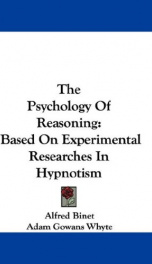
the psychology of reasoning based on experimental researches in hypnotism
Series:
Unknown
Year:
Unknown
Raiting:
3/5
Purchase of this book includes free trial access to www.million-books.com where you can read more than a million books for free. This is an OCR edition with typos. Excerpt from book: CHAPTER III. REASONING IN PERCEPTION. In external perception the images which arise in us from contact with objects derive a group of properties from their origin which are entirely wanting in isolated images, which we studied in the preceding chapter. Directly suggested by exterior impressions, they associate themselves organically with these impressions, so as to form an indivisible whole which corresponds to the idea of a single object. By means of this sensory bond each image consequently undergoes all the modifications which the sensation directly experiences. Practically, as regards the observer, it behaves like a true sensation. The chapter which follows might therefore be entitled: '' The properties of images which are associated with sensations. In the study of these phenomena we shall turn once more to hypnotic hallucinations, for in the normal state they are too weak to be observed. But here a preliminary objection arises: How can the hallucination be of use in the study of normal perception, an operation which is produced by a cooperation of the senses and the mind? Is the hallucination not a sort of delirious conception which arises wholly from a diseased brain ? When we say to a hypnotized subject: There is a serpent! and when, looking at the ground, she sees the serpent crawling towards her, what is real, what is objective in this apparition? Such is the objection which may be made a priori. But by carefully observing the hypnotic hallucination (the only one we shall refer to), and also by replacing mere observation by experiment, we find that a part of sensation enters, if not always, at least often, into this phenomenon. This is perhaps not an absolute rule, but the case is very common. Here is a first experiment which proves this: We present a p... --This text refers to the Paperback edition.
Show more
add to favoritesadd In favorites
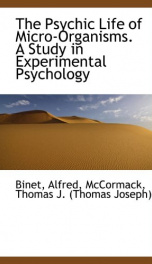
the psychic life of micro organisms a study in experimental psychology
Series:
Unknown
Year:
Unknown
Raiting:
4.5/5
Originally published in 1889. This volume from the Cornell University Library's print collections was scanned on an APT BookScan and converted to JPG 2000 format by Kirtas Technologies. All titles scanned cover to cover and pages may include marks notations and other marginalia present in the original volume.
Show more
add to favoritesadd In favorites
Book list

The Mind and the BrainBeing the Authorised Translation of L'Âme et le Corps
Series:
Unknown
Year:
Unknown
Raiting:
2.5/5
Show more
add to favoritesadd In favorites

the psychology of reasoning based on experimental researches in hypnotism
Series:
Unknown
Year:
Unknown
Raiting:
3/5
Purchase of this book includes free trial access to www.million-books.com where you can read more than a million books for free. This is an OCR edition with typos. Excerpt from book: CHAPTER III. REASONING IN PERCEPTION. In external perception the images which arise in us from contact with objects derive a group of properties from their origin which are entirely wanting in isolated images, which we studied in the preceding chapter. Directly suggested by exterior impressions, they associate themselves organically with these impressions, so as to form an indivisible whole which corresponds to the idea of a single object. By means of this sensory bond each image consequently undergoes all the modifications which the sensation directly experiences. Practically, as regards the observer, it behaves like a true sensation. The chapter which follows might therefore be entitled: '' The properties of images which are associated with sensations. In the study of these phenomena we shall turn once more to hypnotic hallucinations, for in the normal state they are too weak to be observed. But here a preliminary objection arises: How can the hallucination be of use in the study of normal perception, an operation which is produced by a cooperation of the senses and the mind? Is the hallucination not a sort of delirious conception which arises wholly from a diseased brain ? When we say to a hypnotized subject: There is a serpent! and when, looking at the ground, she sees the serpent crawling towards her, what is real, what is objective in this apparition? Such is the objection which may be made a priori. But by carefully observing the hypnotic hallucination (the only one we shall refer to), and also by replacing mere observation by experiment, we find that a part of sensation enters, if not always, at least often, into this phenomenon. This is perhaps not an absolute rule, but the case is very common. Here is a first experiment which proves this: We present a p... --This text refers to the Paperback edition.
Show more
add to favoritesadd In favorites

the psychic life of micro organisms a study in experimental psychology
Series:
Unknown
Year:
Unknown
Raiting:
4.5/5
Originally published in 1889. This volume from the Cornell University Library's print collections was scanned on an APT BookScan and converted to JPG 2000 format by Kirtas Technologies. All titles scanned cover to cover and pages may include marks notations and other marginalia present in the original volume.
Show more
add to favoritesadd In favorites
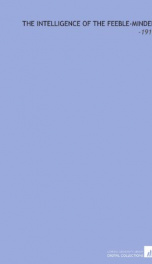
the intelligence of the feeble minded
Series:
Unknown
Year:
Unknown
Raiting:
4.5/5
Originally published in 1916. This volume from the Cornell University Library's print collections was scanned on an APT BookScan and converted to JPG 2000 format by Kirtas Technologies. All titles scanned cover to cover and pages may include marks notations and other marginalia present in the original volume.
Show more
add to favoritesadd In favorites
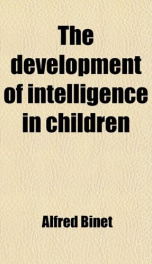
the development of intelligence in children
Series:
Unknown
Year:
Unknown
Raiting:
3/5
Purchase of this book includes free trial access to www.million-books.com where you can read more than a million books for free. This is an OCR edition with typos. Excerpt from book: APPLICATION OF THE NEW METHODS TO THE DIAGNOSIS OF THE INTELLECTUAL LEVEL AMONG NORMAL AND SUBNORMAL CHILDREN IN INSTITUTIONS AND IN THE PRIMARY SCHOOLS The preceding article contains a strictly theoretical exposition of the methods of diagnosis which we have devised for recognizing and measuring intellectual inferiority. It remains to complete the preliminary work, to standardize it, to show how far these methods work out when applied to real facts. After the theory must come the proof. It will not be a question here of anything but the psychological method. It is the only one which is ripe for complete practical purposes. Other methods can only give accessory indications; but these already permit determinations of intellectual inferiority. This is our conviction; we are now going to give the palpable demonstration. The psychological examination of a subject lasts on an average 40 minutes. We made in the beginning many useless tests with each child, because we were doing a work of investigation; we were groping; now that one knows what to look for, one can proceed more rapidly, and we believe that a half-hour will suffice to fix the state of the intellectual development of each child. We shall study successively with our measuring scale of intelligence: 1. Normals. 2. Subnormals in institutions. 3. Subnormals in primary schools. I. Normal Development Of The Intelligence With Children From Three To Twelve Years Old Normals figure here as terms of comparison. We have been obliged to make these lengthy studies, because, up to the present, nothing of the kind existed. So far as we know, there is no work that contains the precise and detailed history of the development of the intelligence of a child. The most complete monographslike those of Allen Gilbert1 p...
Show more
add to favoritesadd In favorites
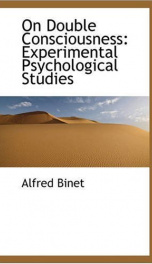
on double consciousness experimental psychological studies
Series:
Unknown
Year:
Unknown
Raiting:
4.5/5
An unabridged reprinting of the 1905 New Edition, with all text digitally enlarged. --This text refers to an alternate Paperback edition.
Show more
add to favoritesadd In favorites
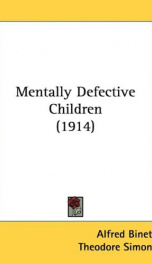
mentally defective children
Series:
Unknown
Year:
Unknown
Raiting:
3.5/5
With An Appendix Containing The Binet-Simon Tests Of Intelligence And An Introduction By Professor Alexander Darroch. Translated by W. B. Drummond.
Show more
add to favoritesadd In favorites
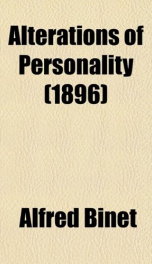
alterations of personality
Series:
Unknown
Year:
Unknown
Raiting:
4.5/5
Purchase of this book includes free trial access to www.million-books.com where you can read more than a million books for free. This is an OCR edition with typos. Excerpt from book: CHAPTER III. INDUCED SOMNAMBULISM. We may now leave the account of spontaneous alterations of consciousness and enter the domain of phenomena artificially induced. We shall thus endeavour to study the divisions of personality which may be produced in the laboratory. The importance of these experiments, and, above all, their psychological value, have been very differently estimated within the last few years. At first, when studies on hypnotism and somnambulism were brought into favour by M. Charcot, there was a movement of great enthusiasm. Since thenwe may as well admit itenthusiasm has diminished a little. One may see for himself that these studies present a great many loopholes to error, which very often perverts the results despite the precautions of the most careful experimenter ; and no one can boast that he has never failed. One of the chief and constant causes of mistake, we know, is found in suggestionthat is to say, in the influence that the operator exerts by his words, gestures, attitudes, even by his silence, on the subtle and alert intelligence of the person whom he has put in the somnambulistic state. But these causes of error should not lead us toabandon such a fruitful method. All processes of observation are shown after long use to be defective from some standpoint. It is so in the case of the graphic method, which, though so wonderful in many cases, still gives rise to serious misapprehensions of the forms of movements. Anatomy itself, which of all the biological sciences seems to be most firmly established, may be mistaken and take appearance for reality. The observer must be wide-awake and constantly on his guard in using his method and his apparatus. The chief precaution to be taken here consists, as I have already said, in selecting out those o...
Show more
add to favoritesadd In favorites
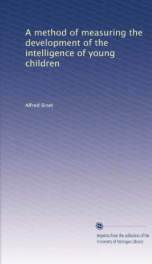
a method of measuring the development of the intelligence of young children
Series:
Unknown
Year:
Unknown
Raiting:
4/5
This volume is produced from digital images created through the University of Michigan University Library's large-scale digitization efforts. The Library seeks to preserve the intellectual content of items in a manner that facilitates and promotes a variety of uses. The digital reformatting process results in an electronic version of the original text that can be both accessed online and used to create new print copies. The Library also understands and values the usefulness of print and makes reprints available to the public whenever possible. This book and hundreds of thousands of others can be found in the HathiTrust, an archive of the digitized collections of many great research libraries. For access to the University of Michigan Library's digital collections, please see http://www.lib.umich.edu and for information about the HathiTrust, please visit http://www.hathitrust.org
Show more
add to favoritesadd In favorites
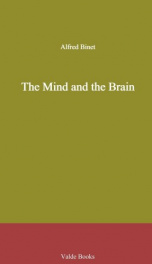
The Mind and the Brain
Series:
Unknown
Year:
Unknown
Raiting:
3.5/5
The Mind and the Brain. please visit www.valdebooks.com for a full list of titles --This text refers to the Kindle Edition edition.
Show more
add to favoritesadd In favorites
What readers are saying
What do you think? Write your own comment on this author!
write a commentGenre
- Books
- Nonfiction / Politics
- Literature & Fiction / Classics
- Professional & Technical / Professional Science / Biological Sciences / Zoology / General
- Nonfiction / Education / Education Theory / History
- Religion & Spirituality / Christianity / Theology
- Science / Juvenile literature
- Reference / Atlases & Maps / World
- Health, Mind & Body / Psychology & Counseling / Adolescent Psychology
if you like Binet Alfred try:
readers also enjoyed
What readers are saying
What do you think? Write your own comment on this author!
write a commentGenre
- Books
- Nonfiction / Politics
- Literature & Fiction / Classics
- Professional & Technical / Professional Science / Biological Sciences / Zoology / General
- Nonfiction / Education / Education Theory / History
- Religion & Spirituality / Christianity / Theology
- Science / Juvenile literature
- Reference / Atlases & Maps / World
- Health, Mind & Body / Psychology & Counseling / Adolescent Psychology
if you like Binet Alfred try:
readers also enjoyed
Do you want to exchange books? It’s EASY!
Get registered and find other users who want to give their favourite books to good hands!

